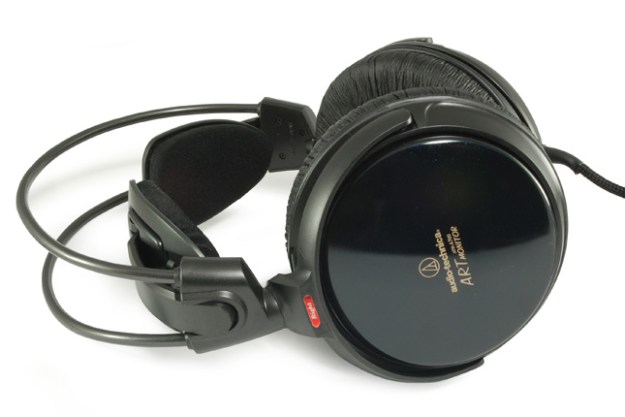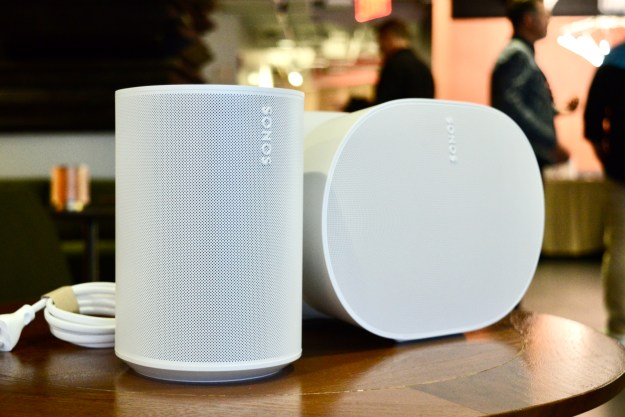
“The close-backed ATH-A700 outperforms its open-backed cousin in every way, seizing a deserved spot at the top of the heap for this price range.”
- Excellent midrange production
- Rich Bass
- Sturdy construction
- Cloth-covered 10-foot cord
- Bulky
- No storage or transport case
- Require a powerful source

Out of the Box
As with the AD700 headphones, Audio-Technica has foregone premium packaging efforts in order to keep the cost of the A700’s down. The
 Features and Design
Features and Design
The ATH-A700’s utilize a large 53mm driver that is angled back toward the ear from within the ear-cup. The inside of the ear-cup is heavily padded, and lined with a leather-like material, instead of the coarse velvet that lines the AD700 ear pads. The cloth-covered cord, which leads off of the left side earphone, stretches an impressive 10 feet and is terminated with a 1/8-inch mini plug. Here, Audio-Technica has employed a more commonplace 1/8-inch jack and ¼-inch adapter, rather than the threaded type found on the AD700. As a result, we had no problems fully inserting the native connector into our iPhone, iPod Touch or headphone amplifier.
The ATH-A700, like the ATH-AD700, ATH-AD500 and ATH-W5000’s, utilize two “3D paddles” mounted to a frame to support the
The extremely large, circumaural (around the ear)
 Performance
Performance
To audition the ATH-A700, we employed the use of an iPhone 3G, iPod Touch, Dell D810 Laptop, Marantz SR7005 A/V receiver, Pioneer turntable with Ortofon OM5E cartridge, Bellari phono pre-amp, HeadRoom micro DAC and HeadRoom micro amp.
In our review of the ATH-AD700’s, we struggled to understand the use of the 3D paddle suspension system. It fit so poorly and was so frustrating that we often found ourselves eager to remove the

Speaking of midrange: The A700’s offer the same lush, tuneful and life-like midrange characteristics as the AD700’s. Vocals are remarkably clean and full, while string instruments take on body warmth not often heard with smaller cans. Even brass instruments benefit from the even timbre of the A700’s. For midrange aficionados, the A700s are a serious competitor in the sub-$500 category.
And so we come to the treble attributes of the A700. We had major concerns here, as the AD700 model were extremely aggressive and bright — enough to overshadow the excellent midrange and adequate bass qualities it exhibited. With the A700, however, much of this out-of-control treble has been quelled. Whether it is due to the closed-back design, or enhanced bass response, we are unsure, but without a doubt the A700 exhibit a tighter control on the highs. Instead of sounding brash and thin, the treble offers a generous amount of sparkle and plenty of high end texture. Our only criticism of the A700’s sound production would have to be at the extreme high-frequency portion of the sound spectrum. We found that the A700 were a little harsh with loud, sibilant sounds found in closely recorded vocals, and super hot recordings. Still, this accounted for just a sliver of our listening experience and wasn’t enough to put us off of the A700’s otherwise unexpectedly stellar sound quality.

Conclusion
The ATH-A700’s succeed in every aspect that the AD700’s fail and, as such, are a radically superior headphone. Given their excellent sound quality, adequate sound isolation, comfortable fit and solid construction, we are happy to say that the AD700’s are an excellent headphone and a slam dunk value at an M.S.R.P. of $179. While they are slightly bulky, do not fold down or come with a storage option, the A700’s solid sound quality is enough to earn them a spot on our recommended headphone list. We suggest that anyone looking for a large headphone with even bass, lush mids and sparkling highs should give the A700 a thorough test drive.
Highs:
- Excellent midrange production
- Rich Bass
- Sturdy construction
- Cloth-covered 10-foot cord
Lows:
- Bulky
- No storage or transport case
- Require a powerful source
Editors' Recommendations
- Ifi says its latest portable DAC restores the missing quality in digital audio
- The 6 best optical audio cables for soundbars and more in 2024
- The best headphones for swimming, chosen by experts
- How we test headphones and earbuds
- $2,199 Hed Unity Wi-Fi headphones are the first to offer lossless hi-res audio






